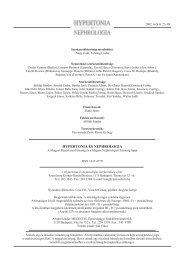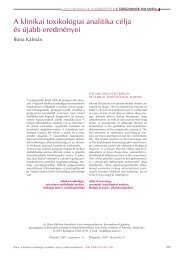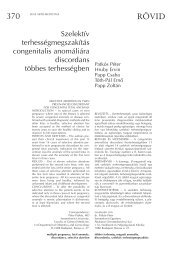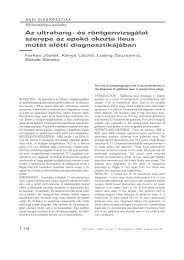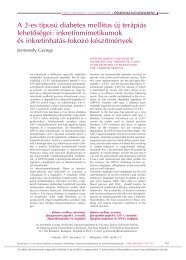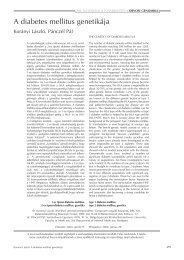HYPERTONIA ÉS NEPHROLOGIA - eLitMed.hu
HYPERTONIA ÉS NEPHROLOGIA - eLitMed.hu
HYPERTONIA ÉS NEPHROLOGIA - eLitMed.hu
You also want an ePaper? Increase the reach of your titles
YUMPU automatically turns print PDFs into web optimized ePapers that Google loves.
2002; 6 (1):3–15. ONTOGENY OF POTASSIUM TRANSPORT IN THE DISTAL NEPHRON 11<br />
The temporal and spatial appearance of ROMK expression<br />
after birth correlates well with our patch clamp analysis of the<br />
apical K + conductance of the differentiating principal cell in<br />
the mid-CCD (19). Apical ROMK was detected in the TALH<br />
at an earlier developmental stage than in the collecting duct.<br />
Functional analysis of the K + transport pathways in the TALH<br />
in the maturing nephron have not been performed. However,<br />
results of micropuncture studies (36) are consistent with<br />
functional immaturity of the loop of Henle in early in life.<br />
Postnatal increases in diluting capacity (37; 55) and<br />
Na-K-ATPase activity (40) in rat TALH have been reported,<br />
suggesting that K + transport pathways in this segment may<br />
undergo developmental regulation. Characterization of these<br />
pathways and the role of apical ROMK in ion transport in the<br />
neonatal segment have yet to be accomplished.<br />
In sum, the results of our investigation suggest it likely that<br />
the postnatal increases in number of conducting apical SK and<br />
Na + channels in the differentiating principal cell are mediated,<br />
at least in part, by increases in abundance of ROMK message<br />
and protein and ENaC subunit proteins. The signal(s)<br />
mediating these developmental events remain to be identified.<br />
rate of<br />
K secretion<br />
(pmol/min.mm)<br />
30<br />
25<br />
20<br />
15<br />
10<br />
5<br />
0<br />
Burg’s perf<br />
5mMTEA<br />
0,5 1,5 3 5-6<br />
#<br />
flox rate (nl/min.mm)<br />
*<br />
Although apical SK channels were not detected by patch<br />
clamp analysis of neonatal principal cells, maxi-K channels<br />
were routinely detected in ~10% of cell-attached patches<br />
obtained in 1- to 5- week-old rabbits (19; 26). The high<br />
conductance (>100 pS) maxi-K channel is rarely open at<br />
physiologic membrane potentials but can be activated by<br />
membrane depolarization, elevation of intracellular Ca 2+<br />
concentration ([Ca 2+ ]i ), membrane stretch or hypoosmotic<br />
stress (56-61). These observations have led to the speculation<br />
that the maxi-K channel, considered not to play a major role in<br />
baseline K + secretion in the CCD, functions in cell volume<br />
regulation (57; 62) and/or flow-mediated K + secretion (59;<br />
61).<br />
To directly examine the contribution of the maxi-K channel<br />
to flow-stimulated K + secretion in the CCD, we examined the<br />
effects of luminal tetraethylammonium (TEA) and charybdotoxin,<br />
both inhibitors of maxi-K (56; 59; 61; 63; 64) but not<br />
SK channels (48; 49), or apamin, an inhibitor of small<br />
conductance Ca 2+ -activated K + channels, on flow-stimulated<br />
net K + secretion in isolated perfused CCDs. In the absence of<br />
TEA, net K + secretion increased 3-fold as the tubular flow rate<br />
rate of<br />
Na absorption<br />
(pmol/min.mm)<br />
140<br />
120<br />
100<br />
80<br />
60<br />
40<br />
20<br />
0<br />
Burg’s perf<br />
5mMTEA<br />
0,5 1,5 3 5-6<br />
flox rate (nl/min.mm)<br />
Figure 9. Flow-stimulation of net K + secretion (left) and Na + absorption (right) in the CCD: effect of luminal TEA. Net<br />
transport (pmol/min.mm) was measured in each tubule at 2-3 flow rates in a symmetrical solution simulating an<br />
ultrafiltrate of rabbit plasma. Data were grouped into flow rate intervals and averaged. Each data point represents the<br />
mean±SEM of 6-11 tubules. In the absence of TEA (black bars, left panel), net K + secretion increased with increasing<br />
flow rate (p



